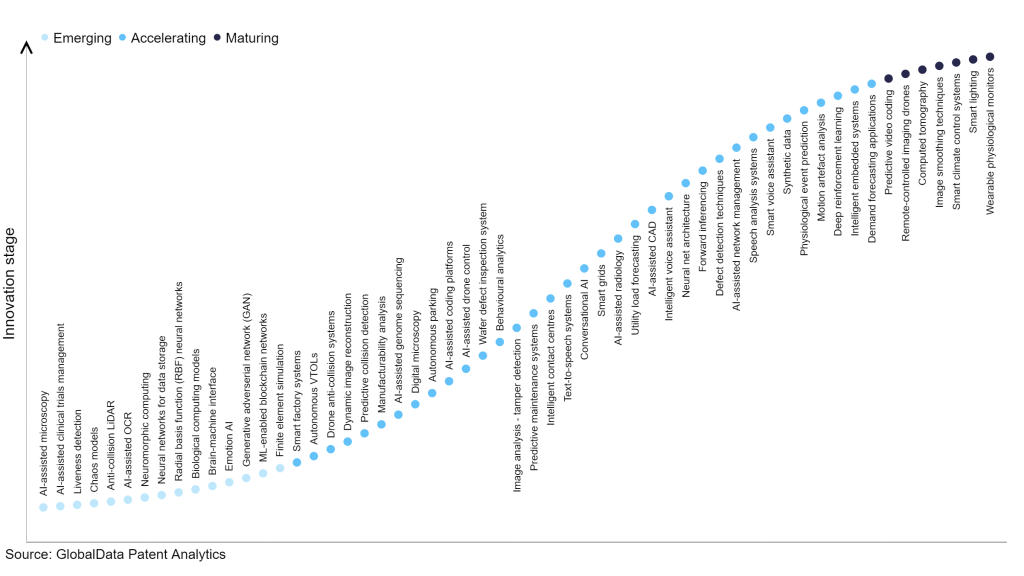Who are the leading innovators in ML-enabled blockchain networks for the technology industry?
[gpt3]rewrite
The technology industry continues to be a hotbed of innovation, with activity driven by the growing demand for secure and transparent data management, the need for advanced analytics and insights, and the potential for cost reduction and efficiency improvement, as well as the growing importance of technologies such as machine learning (ML) algorithms, distributed ledger technology, cryptographic techniques and consensus mechanisms. These technologies enable the development of intelligent, secure and decentralized systems that have the potential to transform various industries such as finance, supply chain, healthcare and more. In the last three years alone, there have been over 3.6 million patents filed and granted in the technology industry, according to GlobalData’s report on Innovation in Artificial Intelligence: ML-Enabled Blockchain Networks.
However, not all innovations are equal, nor do they follow a constantly upward trend. Instead, their development takes the form of an S-shaped curve that reflects their typical life cycle from early emergence to accelerating adoption, before finally stabilizing and reaching maturity.
Identifying where a particular innovation is on this journey, especially those in emerging and accelerating stages, is critical to understanding their current level of adoption and the likely future trajectory and impact they will have.
300+ innovations will shape the technology industry
According to GlobalData’s Technology Foresights, which plots the S-curve of the technology industry using innovation intensity models built on over 2.5 million patents, there are 300+ areas of innovation that will shape the future of the industry.
Within shows up innovation stage, finite element simulation, ML-enabled blockchain networks and generative adversarial network (GAN), are disruptive technologies that are in the early stages of application and should be closely watched. Demand forecasting applications, intelligent embedded systems and deep reinforcement learning are some of these accelerating innovation areas, where adoption has been steadily increasing. Among matures areas of innovation are wearable physiological monitors and smart lighting, which are now well established in the industry.
Innovation S-curve for artificial intelligence in the technology industry

ML-enabled blockchain networks are a key area of innovation in artificial intelligence
ML-enabled blockchain networks are distributed ledgers that leverage machine learning algorithms to analyze and process data stored on the blockchain, enabling the use of predictive analytics, artificial intelligence, and advanced technologies. These networks offer improved efficiency, security and reliability compared to traditional blockchain networks. They enable improved asset management, smart contract creation and provide secure and transparent payment solutions.
GlobalData’s analysis also uncovers the companies at the forefront of each area of innovation and assesses the potential reach and impact of their patenting activity across different applications and geographies. According to GlobalData, there are 30+ companies, spanning technology vendors, established technology companies, and up-and-coming startups that are engaged in the development and application of ML-enabled blockchain networks.
Key players in ML-enabled blockchain networks – a disruptive innovation in the technology industry
“Application diversity” measures the number of different applications identified for each relevant patent, dividing companies into either “niche” or “diversified” innovators.
“Geographical scope” refers to the number of different countries each relevant patent is registered in, and reflects the breadth of geographic application intended, from “global” to “local.”
Patent volumes related to ML-enabled blockchain networks
Source: GlobalData Patent Analytics
Cisco Systems is a leading patent applicant in the domain of ML-enabled blockchain networks. One of the company’s patents focuses on automating application dependency mapping in a network. The network captures traffic data using a sensor network and analyzes it to identify network endpoints and configurations. The network partitions the endpoints based on configurations, measures their similarity, and determines clusters for an application dependency map. The relationship between clusters forms the edges of the map.
Other prominent patent applicants in the area include International Business Machines (IBM) and Furukawa.
In terms of geographic reach, eBay leads the pack, followed by Sita Information Networking Computing UK and Mastercard. In terms of application diversity, DexCom holds the top spot, followed by eBay and British American Tobacco.
ML-enabled blockchain networks can revolutionize the blockchain industry by combining the power of artificial intelligence and machine learning with the transparency and security of blockchain technology. ML-enabled blockchain networks leverage AI algorithms to analyze large amounts of data on the blockchain, identify patterns, and make intelligent predictions and decisions. This enables improved data analysis, fraud detection and smart contract automation. To further understand how artificial intelligence is disrupting the technology industry, access GlobalData’s latest thematic research report on artificial intelligence (AI) – Thematic Intelligence.
[gpt3]



